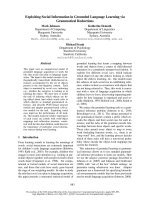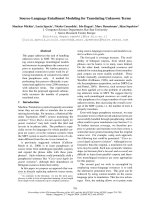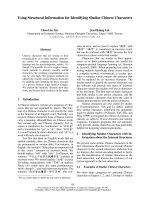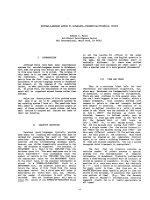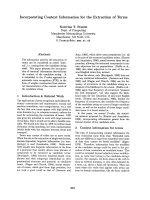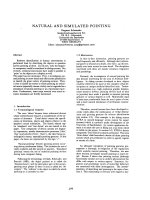Báo cáo khoa học: "natural language information retrieval system DIALOG" potx
Bạn đang xem bản rút gọn của tài liệu. Xem và tải ngay bản đầy đủ của tài liệu tại đây (597.73 KB, 9 trang )
NAmlmAL LANGUAGE INFO~4ATION RET£IEV~ SYST~4 DI.&LOG
L. 9o]0, K. Kochut, A. Le§niewski I, T.
Strzalkowski 2
Warsaw University
Institute of Informatics
PKIN, pok.850
00-901 Warszawa
POLAND
~BSTRAe~
Presented paper contains a descrip-
tion of an experimental version of the
natural language information retrieval
system DIALOG. The system is destined
for the use in the field of medicine.
Its main purpose is to ensure access to
information to phlsiclans in a conver-
sational manner. The use of the system
does not require ability of programming
from its user.
I Introduction
The paper presents the state of
elaboration of the natural language in-
formation retrieval system DIALOG. Its
aim is an automatic, conversational ex-
traction of facts from a given text.
Actually it is real medical text on
gastroenterology, which was prepared by
a team of specialists. The system has
a modular structure.
The first, and in fact very import-
ant module is the language analysis mod-
ule. Its task is to ensure the transi-
tion of a medical text from its natural
form, i.e. rentences formed by phys-
icians, into a formal ~ogical notation.
This logical notation, i.e. logical for-
mulae, is rather universal and can be
easy adapted to various deductive and
knowledge representation methods. The
program of the analyser was written with
the use of the CATN /Cascaded ATN/ tech-
nlque, where the syntactic and semantic
components constitute separate cascades.
In the deduction and knowledge rep-
resentation module the weak second order
language was used. The works by E.Konrad
/Konrad 76/ and N.Klein /Klein 78/ from
the Technical University in Berlin were
I Presently:
Universitat Stuttgart, Institute
fur Informatlc, Herdeweg 51Raum 4,
Postfach 560.7000 Stuttgart, FRG
2 Presently: °
Simon Fraser University, Dept. of
Computing Sci., Burnaby, B.C. Canada
the starting ~oint in the e!abor~tion of
this module.
Presented version of the system was
implemented on the IBM 370 computer /~.I
370 operating system/.
2. Transformation of natural language
sentences into logical formulae
The user of the DIALOG system intro-
ducing his utterance into the system
comes into direct contact with the natu-
ral language analysis module. This mod-
ule plays the key role in the machine
natural lang1~age communication process.
Similarly as in many other information
systems of this type, e.g. L[fMAR /Woods
72/, PLANES /Yaltz 76/, SO~FIF, /~urton
76/, RENDEZ-VOUS /Codd 78/, PLIDIS
/Berry-Rogghe 78/, OIALOGIC /Grosz eta].
82/, the purpose of the module is to
transform a text in the natural language
into a chosen formal representation. Suc~
Such a representationmust meet a number
of requirements. Firstly, it must be
"intelligible" to the internal parts of
the system, i.e. the deductive comoonent
and/or managing the data base. Secondly,
it must carry in a formal, and clear man-
er the sense and meaning of utterances
in natural language. Finally, the repre-
sentation should allow for a reproduc-
tion of the original input sentence with
the aim of generating intermediate para-
phrases and/or answers for the user.
In the parser of the DIALOC, system,
we attempted on the gratest, in our
opinion, achievements in the field of
natural language processing. The follow-
ing works had the greatest influence on
the final form of the module: /Berry-
-Rogghe 78/, /Bates 78/, /Carbonell 81/,
/Cercone 80/, /Chomsky 65/, /Ferrari
80/, /Fillmore 68/, /Gershman 79/,
/Grosz 82/, /Lnndsbergen 81/, /Marcus
80/, /Martin 81/, /Moore 81/, /Robinson
82/, /Rosenschein 82/, /Schank 78/,
/Steinacker 82/, /Waltz 78/, /Wi]ensky
80/, /Woods 72/ and /Woods 80/. We have
transferred, with greater or less suc-
cess, the most valuable achievements
presented in these works, pertaining
t96
mainly to the English language process-
ing, into our system, using them in the
treatment of the Polish language. We
attempted thus, to preserve a certain
distance with regard to the language it-
self, as well as the subject of conver-
sation with the computer, so that the
adapted solutions were of a broader
character and through that became com-
parable with the state of research in
that field in other countries.
2.1.The role, wlace and structure of
the language analysis module
The purpose of the language analy-
sis module in the DIALOG system is tran-
sformation of the user's utterance /in
Polish/ into the I order logic formulae.
Other formal notations such as II order
logic formulae, FUZZY formulae, Minsky
frames and even the introduction of
intensional logic elements are also con-
sidered. At present, ~e will concentrate
on the process of transforming a natural
sentence into a I order logic formula.
The system is equipped with two
independent modules: deduction and data
base management. The data for these mod-
ules are the formulae generated by the
parser. We will present only one module
working on the basis of the we~( second
order logic.
The parsing system consists of the
two closely cooperating parts: a syntac-
tic analyser and a sem(nntlc interpreter.
The whole was programmed with the aid o~
a mechanism called CATN /Cascaded ATN/
/Woods 80/, /Bolc, Strzalkowskl 82a,82b/
/Kochut 83/, where the syntactic compo-
nent plays the role of the "upper", i.e.
the dominating "cascade". For the syn-
tactic analyser produces a structure of
the sentence grammatical analysis, which
in turn undergoes a semantical verifica-
tion. In case, where the semantic inter-
preter is not able to give the meaning
of the sentence, the syntactic component
is activated again with the aim of pre-
senting another grammatical analysis. If
such an analysis cannot be found, the
input sentence is treated as incorrect.
2.2. The syntactic analyser
The syntactic component of the par-
ser produces a gra~natical analysis of
the input sentence in Polish. This was
possible due to a skillful programming
of rules governing the morphology and
syntax of the language. Although, the
whole system was oriented towards a de-
fined type of texts /medical/, the ac-
cepted solutions make it a much more
universal tool. We do not claim that the
syntactic analyser in its present fol-m
is able to solve all or the majority of
problems of the Polish language syntax.
It includes, however, rather wide subset
of the colloquial language, enriched by
constructions characteristic for medical
texts.
A natural language sentence intro-
duced into the parser undergoes firstly
a pretreatment in a so called spelling
correcter. If all the words used in the
sentence are listed in the system vocabu-
lary then the sentence is passed for syn-
tactic analysis. Otherwise the system
attempts to state whether the speaker
made a spelling error, giving him a
chance to correct the error and even
suggesting the proper word, or whether 11e
used a word unknown to the system. In the
last case, the user has a possibility of
introducing the questioned word into the
vocabulary but in practice it may turn
out to be too troublesome for him. Usual-
ly then, the user is given a chance of
withdrawing the unfortunate utterance or
formulating it in a different way.
The proper syntactic analysis begins
at the moment of activating the first
"cascade" of the parser. It consists of
five ATN nets, with the aid of which the
grammar of the subset of the Polish lan-
guage has been written. The two largest
nets SENTENCE /sentences/ and N0[~-P_RR
/nominal groups/ play a superiorrole in
relation to others: ADH-PT~A /adiective
groups/~ ADV-PT~A /adverb groups2 and
Q-EXPR /question phrases/. The process of
syntactic analysis is usually quite com-
plex and uses essentially the non-deter-
ministic character of orocessing in ATN.
It Is justified by the-specific nature
of the Polish language, which is charac-
gerised by a developed in~ection and a
Sentence free word order.
The result of the syntactic analysis
is a grammatical analysis of the input
sentence in the form of a so called
o-form. It is a nonflexional form of
a sentence, ordered according to a fixed
key. The construction of the o-form can
be expressed ba the structure:
<o-form~ : :=
(S (questiqns) i (negation~ I (modalitie~
l(predlcate/verb)l (vague~ I (subject)
!
~direct objectS_| (indirect object> I
~(pre~. phrase)I}"(CAUSE/RES[~(o-forn~]
END)
The stick mark "|,, is usually used as a
symbol of the meta-language. Here it is
used as a symbol of the defined language.
Symbols S and END comnrise a single
clause. A clause expresses every elemen-
tary activity or event expressed in the
197
input sentence. Often, the o-form has
a richer structure than a classical
analysis tree. The elements of the
o-form called ~subject~ , (direct ob-
Ject~ , (indirect objectS, and ~adJect-
ive phrase) can also be expressed or
modified with the use of clauses. The
stick marks "I" separate the parts of
the o-form and are its constatnt ele-
ments. Then transformed nuestion is
subjected to semantic interpretation.
The syntactic analyser manages the
vocabulary, where infle×ional forms of
words are kept. The vocabulary defini-
tion specifies the syntactic categories,
to which given words belong. It also
describes forms of words with the aid of
lexlcalparameters: case, number, person
and gender. These parameters are of gret
value in examining the grammatical con-
struction of sentences.
2.3.
The semantic interpreter
When the syntactic analysis is suc-
cessfully completed the o-form of the
input dentence is forwarded for the sem-
antic interpretation. The syntactic
"cascade" is suspended, i.e. removed
from the operational field, leaving
place for the semantic "cascade". The
configuration of the removed "cascade"
is remembered thus, in case of necessity
of generating an alternative grammatical
analysis.
The semantic interpreter consists
of the two main parts: a constant con-
trolling part, working on the basis of
a very general pattern adjustment, and
compatible experts algorithms, where
the knowledge of the system in the field
of conversation has been coded. The pro-
cess of interpretation is assisted by
a special vocabulary of semantic rules
and on additional vocabulary complement-
ing the expert knowledge.
The sentence in the o-form is for-
warded directly to the controlling part
of the interpreter, where such its par-
ameters as time, negation, aspect
are evaluated first. Then the central
predicative element of the sentence
"calls for" a proper semantic rule,
which from then will guide the interpre-
tation process. The rule has a form of
~ pattern-concept pair /Wilensky 80/
Gershman 79/, /Carbonell 81/, where ~he
pattern reflects the scheme of an ele-
mentary event, wheras the concept indi-
cates how its meaning should be express-
ed through formulae. The semantic rule
is activated for the time of interpre-
tation of a single clause. If the pat
tern is adjusted to the cl~use, an
atomic formula is generated, expressing
the meaning of the clause. The meaning
of the whole sentence is expressed as
a logical combination of meanings of all
the o-form clauses. The semantic rules
bring different /on the surface/ descrip-
tions of the same phenomenon into a com-
mon interpretation.
The.general structure of formulae
generated by the interpreter is ex-
pressed by an implication:
41^~2^ ^~n-~
"where ~ has been introduced from a sem-
antic rule and~i come from the system
knowledge - special compatible parts
of the interpreter called the experts.
Individual o-form phrases, in the con-
text of the dialogue subject, are inter-
preted in experts.
In our system, designed for conver-
sation with a phlsician, we have experts
for names of sicknesses /SICKNESS/,
names of ~rgaus /ORGAN/, internal sub-
stances /oUBSTANCE/, therapies /TREAT-
~NT/, medicaments /MEDICAmeNT/ and
names of animate objects /ANIMATE/ and
the remaining objects foreign to the
body /PHYSOBJ/. Experts are activated
on the request of a proper semantic rule.
The controlling part of the inter~eter
"instructs" the expert/s/ chosen by the
pattern to interpret a notion or expres-
sion. The indicated expert can solve the
problem on its o~m or seek for the help
of other experts. Often, one complex ex-
pression has to be gualified by two or
three exprrts.
All the experts, as well as the
controlling part of the interpreter
/FOR~UJLA, CASES and QWORDS nets/ have
been recoreded in ATN formalism and form
a lower "cascade" of the parser.
The interpreter is also egulpped
with a mechanism of context pronominal
reference solution.
2.4. Examples of transformation of a
medicaltext into logical formulae
We will present two examples of
transformation of medical sentences into
I order logic formulae. Before that,
a few words on the adopted convention of
formula notation. The symbols IMPLSYM
and KONJSYM are logical operators
/implication/ andS/conjunction/ re-
spectively. Integer placed directly
after the symbol KONJSYN indicates the
number of conjlmction factors. Names of
predicates are preceded by symbols '~"
7hash mark/, and an integer placed right
to the name defines the number of predi-
198
cate arguments. The arguments specify
their type /sort/, name of the variable
and constant /if there is one/.
Example
1
Sentence :
Alkehol powoduje r6wnie~ wzrost napi~-
cia mi~ni6wki dwunastnlcy.
/Alcohol also causes the rise of the
tenlcity of the duodenum muscular
coat/
o-form:
(s
DC~
I I I I ~O:'IODOWAC I RO~VWIEZ I
A~KOHOL
I
s
! II I
WZR0ST
III
NAPIECIE
MODIFIERS NIESNIOWFA DWU~fASTNICA
~I ~ END J I I END)
formula:
(If.TPLSYM
(KONJSYM 3 ((~tBADf.TE, DIC 1) (r.~OlO X44))
((I~I~EDICIC.,'E, NT 2) (P.~DIO X44) (f.S~A~TE
X45
ALJ<OT-TOL ))
(IMLSYM
(KONJ~
+(~','~YDZ-NARZA~
I)
(ORGAN X+9))
((~0RGAN 2) (ORGAN X+9) (0NINE
X50
DWUNASTNIOAB
((~PART-OF-ORGAN 3) (BODY X48)
(PNAME X51 NIESNIOWKA)
[ORGAN X49 ))
((# SICKNESS 4)(SIeIC X47)
(STYPE X52 FIZJ)
(SNAME X53 NAPIECIE)
(BODY X48)))
((SRISE 2) (SYI,TPTON X46} (SYI.FPTON X47)
((~IMPLY 3)(INFER X43)(P-~EDIC
X4:4J
)}J
(SIOKNESS X46)))
Example 2
Sentence :
Czy alkohol mo~e by6 przyczyn~ 0ZT?
/Can alcohol be the cause of acute
pancreatitis ?/
o- form:
(S CZY II N0C I I BYO II AI:KOHOL I
PRZYCZYNA ~'ODIFIERS 0STR. ZAPALENIE
TRZUSTKA I II END)
formula:
(NIL
(T~T,SYM
(KONJSIq,~ 6[(aVAGI~ 2)
~CTION
X69)
(VAG XTO M00))
((UBADfTDIO I) (MEDIC X71))
((~MEDICAHENT 2) ~.[EDIC X71)
(~A~[E X72 ALKOHOL))
((~ORGAN 2) (ORGAN X74)
(ONm+~, X75 TRZUSTKA))
((~'~DZ-NARZAD I; (ORGAN XV4)
[~SIC]~fESS 4)(SICK X73) (STYPE
X76 PATO) (SNA~ X77 OZT)
{BODY X76 )))
[(:~IMPLY 3) (INFER X69) (ETIO X71)
(STOKNESS
x73))))
.
The deduction and knowledge repre-
sentation module
The deduction module is a separate
part of the whole DIALOG system. Its maiz
purpose is to collect and represent the
knowledge gained by the system and also
the ability to use the possessed infor-
mation in accordance with the wishes of
the user of the system.
Our work on the achievement of the
objectives indicated above was based on
the experiences pre~ented by E.Konrad
and N.Klein /Konrad 76/, /Klein 78/ from
Technical University in West Berlin.
In the previous chapter we present-
ed how the text, written in Polish, is
transformed into I order logic formulae.
This, of course, implies the way of rep-
resentation of the knowledge presented
in the natural language.
3.1. Knowledge representation
The information included in the
logical formulae coming from the lan-
guage module has to be stored for later
use. The logical formulae are then in-
troduced into the data base. The data
base, adequately filled with the men-
tioned formulae, constitutes the knowl-
edge represenlation carried through the
natural language sentences. It is as
equivalent to the text as the I order
logic allows to convey the meaning of th~
natural language sentences.
Data Base
The date base consists of three sep-
arate parts: a nucleus, ~ amplifier and
a filter /Konrad 76/. Each of the parts
includes a different , from the concep-
199
%
tional point of view, elements:
A. The nucleus includes groud literals,
which represent facts occuring in the
field of knowledge represented in the
base. E.g.the information that the pan-
creas is a secretory organ is presented
as a literal
(~ WYDZ-NARZAD (TRZUSTtfA)~
From the system point of view there is
no conceptional difference between the
tee facts: the above one,and
(ORGAN ([nRZUSTKA))
Thus the type /sort/ ORGAN may be re-
garded as a predicate and the above
atomic formula as true one.
B. The amplifier is a part representing
the "fundamental" knowledge of the
system. The formulae included in the
amplifier can be devided into three cat-
egories:
I/ dependent formulae
/i/Vx~ ~s~ VXnCS~ A~x~, ,x~,Ixf=~
A is here any formula and n a predi-
cate. As we can see each variable,
bound by the universal ~uantifier is
of a specified sort.
2/ independent formulae
/ii/ ~XlrSS ~Xn(S ] ~(Xl, Xn)
3/ restrictive formulae
/iii/Vx
1Cs] ~ XngS] l~(xl, ,x n)
The majority of the formulae generated
by the language analysis module is of
the /i/ form.
C. The filter contains the formulae
representing the Imowledge necessary
to preserve the integrity of the data
base.
FILTER
NUCLEUS
AMPLIFIER
RESULTS I
.~. MODIFYING I
CO~ANDS
I I
l i
INTERPRETER
Fig. I. Diagram of the data base
system /Konrad 76/
Recapitulating, the nucleus repre-
sents the extensional part of the know-
ledge represented in the data base. It
is the fundamental knowledge which can-
not be obtained from the amalysis of the
presented text, and which is assential
to proper deduction. The amplifier
represents the intensional part of the
data base. The knowledge represented
there is a co31ection of statements used
for deduction.
Each of the logical formulae is
kept in a certain internal form, corre-
sponding to the way of deduction, de-
scribed later on. As we have already
mentioned, the majority of formulae is
of the /i/ form. Every such formula is
converted, at the moment of inserting
into the data base, to a pair of the
following form:
(~conclusion~premises testing procedure)
3.2. The knowled6e extraction
Because of the menner of storing
the knowledge described in the point 3.1,
the answer to the question presented to
the system does not have to be represent-
ed explicite in the data base. The de-
duction module should be able to obtain
all the information included in the data
base.
The questions presented to the sys-
tem are also converted to the logical
formulae. Thus, the extraction of knowl-
edge is reduced to the verification of
a given formula towards the present con-
tent of the data base.
The logical formula representing
the question is converted to an appro-
priate LISP form. Evaluation of such
a form is equivalent to examination
whether the represented by it formula is
true. This form correspond to the normal
form of the logical formula /LISP func-
tion AND, OR and NOT are used/. The
literals are tested by a TESTE function
according to the following algorithm:
I. Check the amplifier, trying to find
the rule with the conclusion unifi-
able with the literal under proof. If
such a formula does not exist that there
is no proof of a given literal;
2. If there is such a formula then:
a. if it is indicated as an indepen-
dent formula then STOP with a proof
b. if it is indicated as a restrictive
formula then STOP without a proof~
c. otherwise evaluate the form asso-
ciated with the conclusion; if we
obtain NIT, /false in LISP/ then
search the amplifier for another
rule and go to 2. If we obtain
value different than NIL then STOP
200
I
with a proof.
Otherwise Stop without a nroof.
It is therefore a so called backward
deduction zystem. The nroof goes back
from the formula - aim ~ to the facts,
applying the formulae from the amplifier
in the "Backward" direction.
The answer can be YES or NO or it
can be a list of constants depending on
the kind of question.
The I order logic has been enriched
here with some elements of the II order
language. Predicate variables, quantifi-
cation of these variavles and retrieval
of predicates as well as constants have
been introduced.
3.3. Access to the data base
The system communicates with the
data base through commands of the spe-
cially designed language. These commands
enable introduction and erasing from the
data base.
The basic commands serving the pur-
pose of knowledge extraction are TEST
and FIND:
a. TEST A
- looking for the proof of a formula
A. Answer YES/NO.
b. FIND ~1""11'mX~xl"'xn) ~r~1"';x1" '~
~i - predicate variables
- retrieval of all the pairs: m-tuple
predicates and n-tuple oe constants
which satisfy a given formula A.
3.4. Example
The formula presented in the
example I and a formula below have been
introduced into the amlifier.
Sentence:
Wzrost napi@cia mi~dni6wki d~mnastnicy
mo~e by4 przyczyn~ OZT.
/The rise of the tonicity of the
duodenum muscular coat may be the
reason of acute pancreatitis/
Formula:
(IMPLSYM
(VAC
x84
~oc))
~,~LS~
DW~ASTNIOA~
,((~ART-OF-OROAN ~)(~Y
xe~)
XgO r IESHIO A)
(ORC N X88))
L@szcm~;ss 4) (szc~ ×s6)(S~E X91
FIZJ) (S~A~, X92
~APIECIE) [~0~[ ~S7)))
(@ OROAN
2]
(ORGAN X94) (O~Tm~ X95
TRZUS~KA);
[(# ~:~/DZ-NARZAD I) (ORGAN X94)
((~ SICKNESS 4) (SICK X95) (STYPE X96
PATO) (SNA~:E X97 OZT)(BODY X94)))
((II~$PLY 3)(INFER X85] ~TIO X85)
(SIC~<~TESS X95)))
Formula corresponding to the question is
presented in the Example 2. The ampli-
fier contains the formula describing
transitivity of the predicate I~LY.
Facts - ground literals - were
introduced into the nucleus. E.g.
((~BAD~DIO
(ALI(O~OL)) ,
(WV~DZ-NARZAD (DWUNASTNICA)), etc.
After converting the formulae of theorem~
and question into the LISP form its
evaluation Will find the
answer
to the
question. The answer is of course YES.
4. Conclusion
The results obtained during the
work on the system confirmed our direc-
tion of research. Our further work will
concentrate on constant improvement of
the existing modules. At the sere time
we will undertake attempts of enriching
the system with better deductive modules
such as resolution in modal logic,
default reasoning /Relter/, FUZZY and
Minsky frames.
ACKNO~WLEDGEMENTS
The medical text was prepared by
a team of physicians from the Post-
graduate Education Center in Warsaw
under the leadership of Prof. Dr
J.Doroszewski. Prof. Doroszewskl and his
associates have been giving us constant
assistance in the interpretation of the
medical knowledge included in the pre-
sented text. Due to their creative and
active cooperation we were able to
undertake the elaboration of the de-
scribed system. We would like to express
our cordial gratitude to Prof. Doroszew-
ski and the whole team of doctors.
201
5. References
Bates, M., The Theory and Practice of
Augmented transition Network Grammars
in L.Bolc /ed/ Natural Language Com-
munication with Computers
Berry-Rogghe, G.L., Wulz, U., An Over-
view of PLIDIS a Problem Solving In-
formation System with German as Query
Language, in L.Bolc /ed/ Natural Lan-
guage Question-Answering Systems
Bolc, L., /ed/ Natural Language Communi-
cation with Computers, I, ecture Notes
in Computer Science, Vol 63, Springer
-Verlag 1978
Bolc, L. /ed/ Natural Language Based
Computer Systems, Hanser Verlag and
MacMillan Press, London 1980
Bolc, L. /ed/ Natural LanEuage Question
-Answering Systems, Hanser-Verlag and
MacMillan Press, London 1980
Bolc, L. /ed/ Representation and Proces-
sing of Natural Language, Hanser-Ver-
lag and MacMillan Press, London 1980
Bolc, L., StrzaZkowski, T. Transforma-
tion of Natural Language into Logical
Formulas, Proceedings of the 9Th
International Conf. on Comp. Ling.
1982, North ffolland Pub. Comp., 1982
Bolc, L., StrzaZkowskl, T Natural Lan-
guage Interface to the Question-Answe-
ring System for Physicians, 2nd Inter-
national Conf. on AI and Information
Control Systems of Robots, Conference
Proceedings, 1982
Bolc, L., StrzaZkowski, T., The Automa-
tic Transformation of Medical Text to
a Deductive Data Base, to apDear
Bolc, L. /ed/ The Design of Interpreters
Compilers, and Editors for Augmented
Transition Networks, Springer-Verlag,
Berlin, Heidelberg, New York, Tokyo,
1983
Codd, F.c., Arnold, R.S., Cadiou, J-M.,
Chang, C.L., Roussopoulos, N., RENDEZ
-VOUS version 1. ~m Experimental
English L~nguage euery Formulation
System for Casual Users of Relational
Data Base, RJ 2144, IBM Research Lab.
San Jose 1978
Burton, R., ~rovm, J.S., Semantic Cram-
mars: A Technique of constructing
Natural Language Interfaces to Indus-
trial Systems, BBN Report No. 5587,
Cambridge Ma 1977
Carbonell, J.G., Multi-Strategy Parsing,
Dept. of Comp. Scl., Cornegie-Mellon
Univ., Pittsburgh Pa, 1981
Chang, C.I., Lee, F.C., Symbolic Logic
and Mechanical Theorem Proving,
Academic Press, 1973
Dahl, V., Translating Spanish into Logic
Through Logic, American Jrnl. of Comp.
Linguistics, vol 7., no 3, 1981
Gershman, A.V., Knowledge-Based Parsing,
Research Report 156, Yale [~iverslty,
Dept. of Comp. Sci., 1979
Gro~z, B., Haas, N., Hendrix, G., T{obbs,
J., Martin, P., Moore, R., Robinson,
J., Rosenschein, S., DIALOGIC: A Core
Natural Language Processing System,
Proceedings of the 9th Int. Conf. on
Compo Ling. COLLING'82, North Holland,
1982
Klein, N., Implementierung eines Frage-
-Antwort-Systems aufder Basis der
Predikatenlogik II stufe, Technical
Univ. Berlin, 1978
Kochut, K., Towards the Elastic ATN
Implementation, in L.Bolc /ed/ The
Design of Interpreters, Compilers, and
Editors for Augmented Transition
Networks, Springer-Verlag, Berlin,
Heidelberg, New York, Tokyo, 1983
Konrad, E., Formale Semantic yon
Datenbenksprachen, T[~, Berlin, 1976
Landsbergen, J., Adaptation of Montague
Grammar to the Requirements of Parsing,
reprint from MC Tract 136, Formal
Methods in the Study of Language, J.A.G
Groendijk, T.M.V. Jassen, M.B.J.
Stokhof /ads/ 1981
Marcus, M.M., ATheory of Syntactic
Recognition for Natural Language, The
MIT Press, Cambridge Ma, 1980
Martin,W.A., Church, K.N., Patil, R.S.,
Preliminary Analysis of a Breadth-
First Parsing Method, MIT Laboratory
Comp. Scl., 1981
Moore, R.C., Problems in Logical Form,
Proc. of the 19th Annual Meeting of
the ACL, Stanford, California, 1981
Nilsson, N.J., Principles of Artificial
Intelligence, Springer-Verlag, Berlin,
IIeide]berg, New York, 1982
Rosenschein, S.J., Shieber, S.M.,
Translating English into Logical Form,
Proc. of the 20th Ann. Meetiag of the
ACL, Toronto, 1982
Waltz, D.L., Finin, T.N., Dreen, F.,
Conrad, E., Coodman, B., Hadden, G.,
The PLANES System: Natural Language
Access to a Large Data Base, Techn.
Rap. T-34, Coordinated Sci. Lab.,
University of Illinois, 1976
Wilensky, R., Arens, Y., PTmAN - A Knowl-
edge-Based Approach to Natural Languag~
Analysis, Dept. of Comp. Sci., Univ.
of California, Berkeley, 1980
Woods, W.A., Transition Network Grammars
for Natural Language Analysis,
202
CACM, No 13, 1979, 5~)I-606
Woods, W.A., Kaplan, R.M., Nash-Webber,
B., The LUN#~R Science Natural Lan-
guage Information System: Final Report
BBN Report No 2378, Bolt Beranek and
Newman Inc., Cambridge r~a., 1972
Woods, W.A., Cascaded ATN Grammars,
American Jrnl. of Comp. Ling., vol 6
No I, 1980
203
\
3
